Saphenion®: Venenkleber zur Therapie der Krampfaderthrombose?
Saphenion®: vein glue for the therapy of varicose vein thrombosis?
Saphenion®: Venenkleber zur Therapie der Krampfaderthrombose? Die Thrombose im Bereich der oberflächlichen Stammvenen und Hautvenen (Oberflächliche Venenthrombose – OVT; Thrombophlebitis) ist keine seltene Komplikation, Sie bedarf einer medikamentösen oder auch operativen Therapie, wenn die Thrombose in Richtung tiefe Venen wächst. Diese Situation ist insbesondere bei Thrombosen der Vena saphena magna und Vena saphena parva sowie anderer Stammvenen eklatant und führt in ca. 20% der Fälle auch zur Thrombose der tiefen Venen.
Diese tiefe Venenthrombose – bei der Vena saphena magna ist es die Oberschenkel – / Beckenvene, bei der Vena saphena parva ist es die Knievene, hat ein Lungenembolierisiko von bis zu 60%, sofern nicht umgehend eine effektive medikamentöse und / oder operative Therapie durchgeführt wird. Ganz aktuell müssen wir auch eine hohe Thromboserate infolge der momentanen Covid-19 – Pandemie konstatieren, da Viren (z.b. Covid-19, HIV, Grippe) sich bevorzugt auch in Venenwänden der Beinvenen einnisten und dort entzündliche, thromboseerzeugende Venenwandveränderungen provozieren.
In einem aktuellen Fall haben wir im Rahmen einer geplanten und durchgeführten VenaSeal® – Krampfaderverklebung an 3 Stammvenen auf dem Op-Tisch eine frische Thrombose (ca. 7 Tage alt) der Vena saphena parva gesehen. Der Patient hatte keine wesentlichen Beschwerden, konnte auf Nachfrage auch nur ein leichtes Druckgefühl beschreiben. Der klinische Befund war dazu noch völlig unauffällig.
Wir entschieden uns, nach Aufklärung über die Besonderheit der Erkrankung und das Einverständnis des Patienten, zu einer Katheterabsaugung der frischen Blutgerinnsel aus der Saphena parva und anschließender Verklebung der Venen im Rahmen der geplanten Krampfadertherapie. Selbstverständlich wurde diese Therapie von einer medikamentösen Thrombosetherapie begleitet, wie sie ohne Probleme beim VenaSeal® – Verfahren möglich ist.
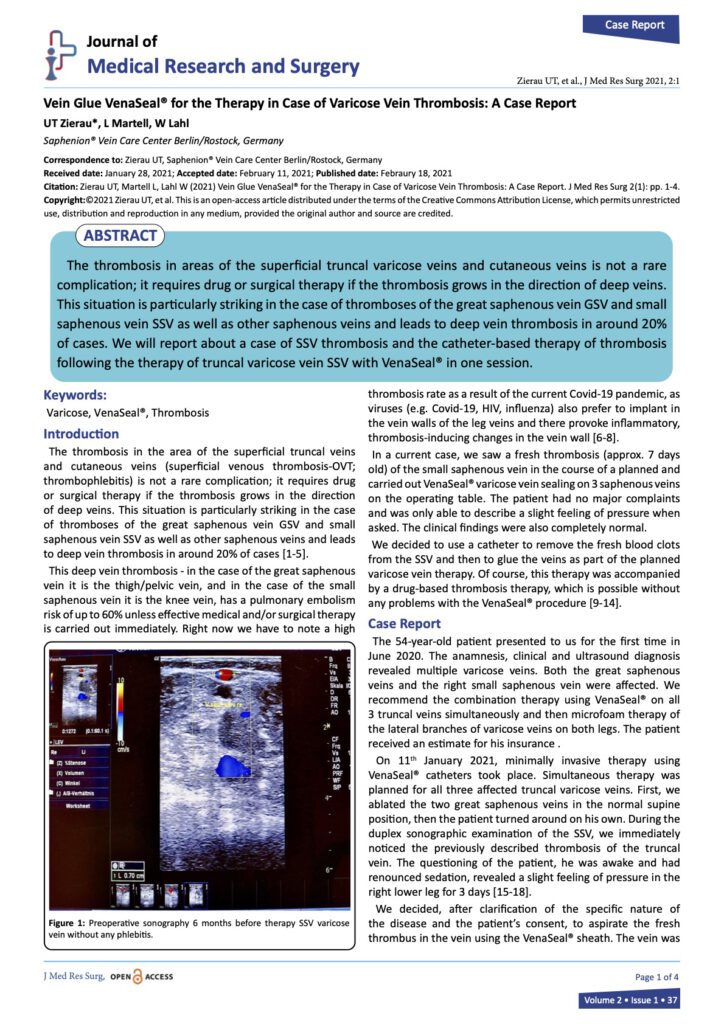
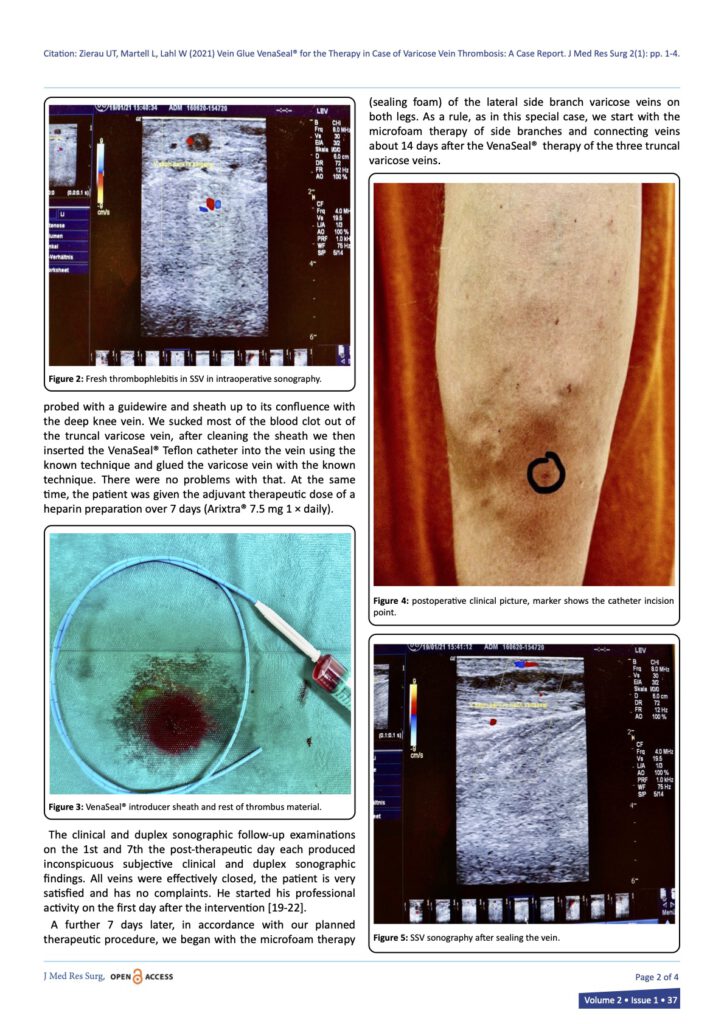
Saphenion®: vein glue for the therapy of varicose vein thrombosis? The thrombosis in the area of the superficial truncal veins and cutaneous veins (superficial venous thrombosis – OVT; thrombophlebitis) is not a rare complication; it requires drug or surgical therapy if the thrombosis grows in the direction of deep veins. This situation is particularly striking in the case of thromboses of the great saphenous vein GSV and small saphenous vein SSV as well as other saphenous veins and leads to deep vein thrombosis in around 20% of cases.
This deep vein thrombosis – in the case of the great saphenous vein it is the thigh / pelvic vein, and in the case of the small saphenous vein it is the knee vein, has a pulmonary embolism risk of up to 60% unless effective medical and/or surgical therapy is carried out immediately. Right now we have to note a high thrombosis rate as a result of the current COVID-19 pandemic, as viruses (e.g. COVID-19, HIV, flu) also prefer to implant in the vein walls of the leg veins and provoke inflammatory, thrombosis-inducing changes in the vein wall.
In a current case, we saw a fresh thrombosis (approx. 7 days old) of the small saphenous vein in the course of a planned and carried out VenaSeal® – varicose vein sealing on 3 saphenous veins on the operating table. The patient had no major complaints and was only able to describe a slight feeling of pressure when asked. The clinical findings were also completely normal.
We decided, after clarification of the specific nature of the disease and the patient’s consent, to use a catheter to remove the fresh blood clots from the SSV and then glue the veins as part of the planned varicose vein therapy. Of course, this therapy was accompanied by a drug-based thrombosis therapy, which is possible without any problems with the VenaSeal® procedure.
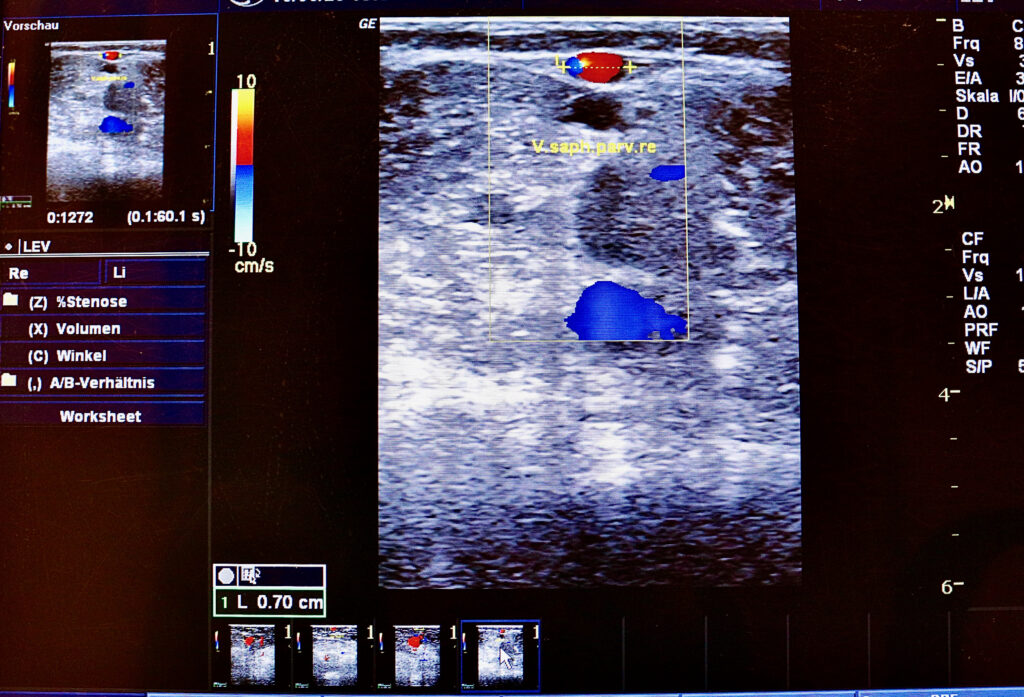
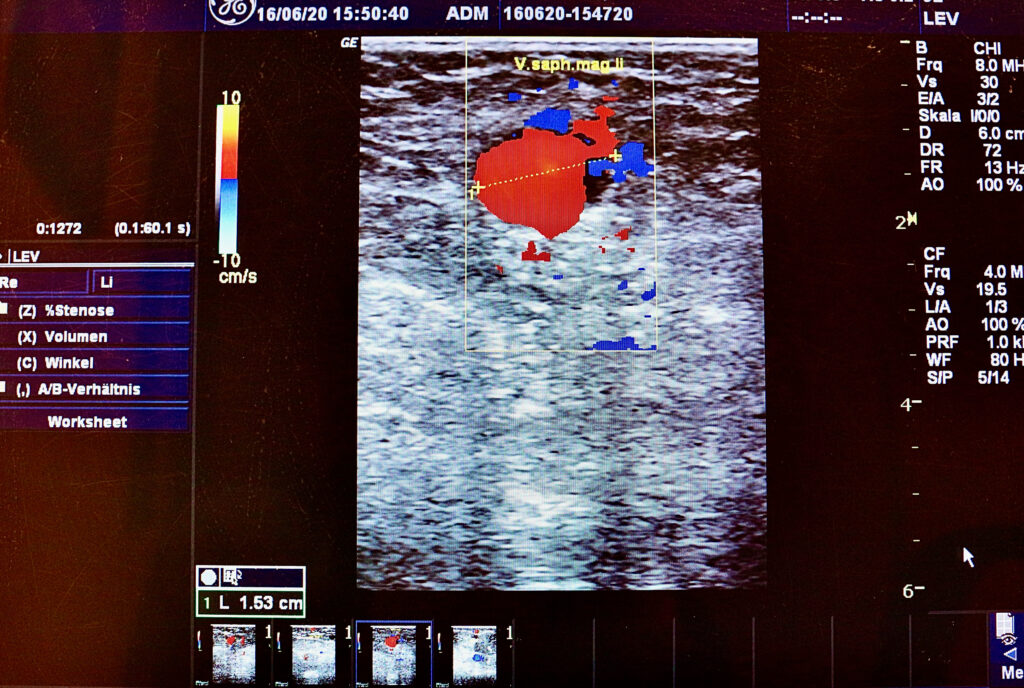
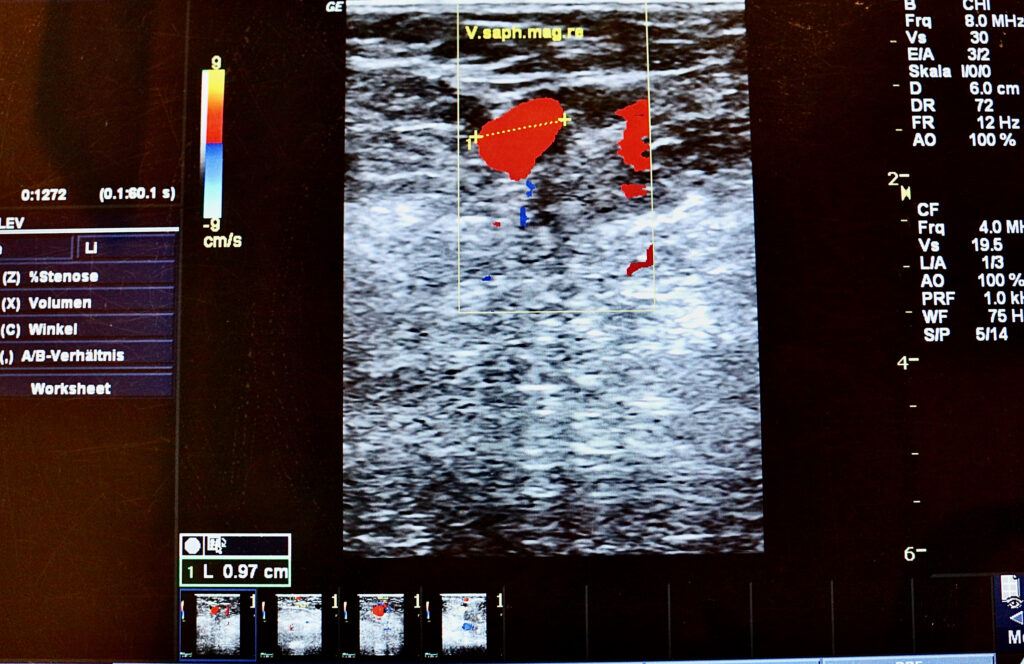
Saphenion®: Venenkleber zur Therapie der Krampfaderthrombose? Die Fallbeschreibung
Saphenion®: vein glue for the therapy of varicose vein thrombosis: The case report
Saphenion®: Venenkleber zur Therapie der Krampfaderthrombose? Der 54 – jährige Patient stellte im Juni 2020 erstmal bei uns vor. Die Anamnese, klinische und Ultraschalldiagnose ergaben den Befund einer mehrfachen Stammvenenkrampfader. Betroffen waren beide Saphena magna – Venen und die rechte Vena saphena parva. Wir empfahlen die Kombinationstherapie mittels VenaSeal® an allen 3 Stammvenen simultan und anschließend Mikroschaumtherapie der Seitenastvaricosis an beiden Beinen. Der Patient erhielt einen Kostenvoranschlag für seine Versicherung.
Am 11.01.2021 erfolgte dann die minimalinvasive Therapie mittels VenaSeal® – Katheter. Geplant war die simultane Therapie aller drei betroffenen Stammkrampfadern. Zunächst ablatierten wir die beiden Saphena magna – Venen in normaler Rückenlage, dann drehte sich der Patient selbstständig in Bauchlage. Bei der duplexsonografischen Untersuchung der Saphena parva fiel uns die bereits beschriebene Thrombose der Stammvene sofort ins Auge. Die Befragung des Patienten – er war wach und hatte auf eine Sedierung verzichtet – ergab ein leichtes Druckgefühl im rechten Unterschenkel seit 3 Tagen.
Wir enschieden uns, die frischen Thromben in der Vene mittels der VenaSeal® – Schleuse abzusaugen. Die Sondierung der Vene mit Führungsdraht und Schleuse gelang bis zur Einmündung in die tiefe Knievene. Wir saugten das Blutgerinnsel weitgehend aus der Stammvene ab, nach Reinigung der Schleuse führten wir dann in bekannter Technik den VenaSeal®-Teflonkatheter in die Vene ein und verklebten die Stammkrampfader. Dabei gab es keinerlei Probleme. Begleitend wurde dem Patienten adjuvant die therapeutische Dosis eines Heparinpräparates über 7 Tage verordnet (Arixtra® 7,5mg 1xtgl.)
Die klinischen und duplexsonografischen Nachuntersuchungen am 1. und 7. post therapeutischen Tag ergaben jeweils unauffällige subjektive klinische und duplexsonografische Befunde, Alle Venen waren effektiv verschlossen, der Patient ist sehr zufrieden und hat keine Beschwerden. Er begann mit seiner beruflichen Tätigkeit bereits am ersten Tag nach dem Eingriff.
Weitere 7 Tage später begannen wir, entsprechend unseres planmäßigen therapeutischen Vorgehens, mit der Mikroschaumtherapie (Sealing Foam) der Seitenastvaricosis an beiden Beinen. In der Regel, wie auch in diesem besonderen Fall, beginnen wir bei allen Patienten ca. 14 Tage nach der VenaSeal® – Verklebung der Stammvaricosis mit der Mikroschaumtherapie von Seitenästen und Verbindungsvenen.
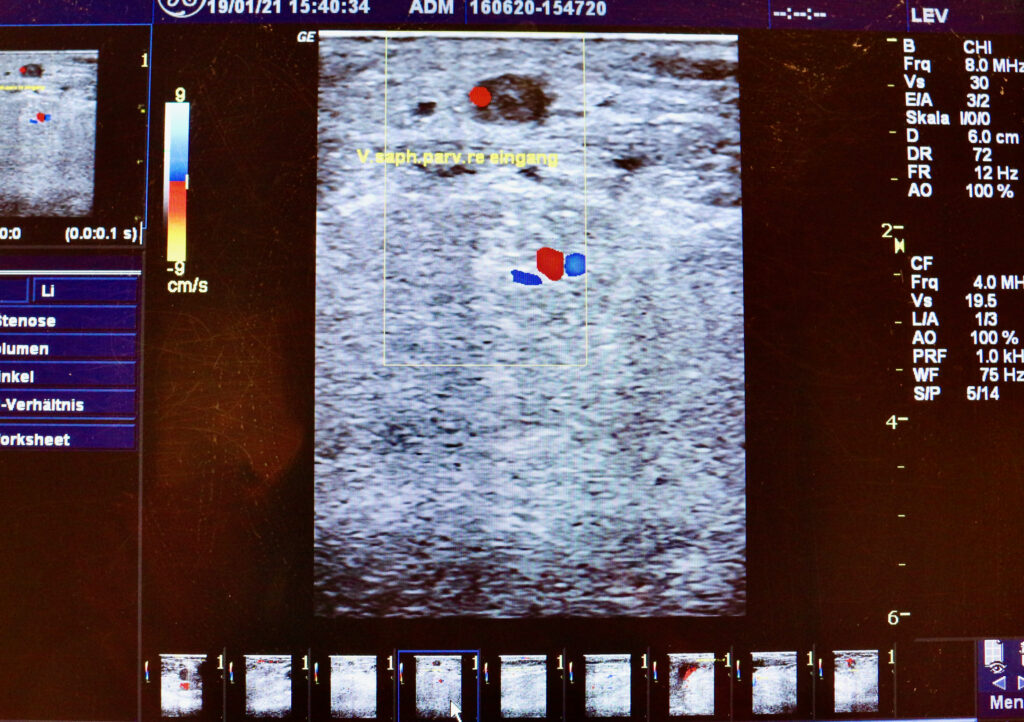
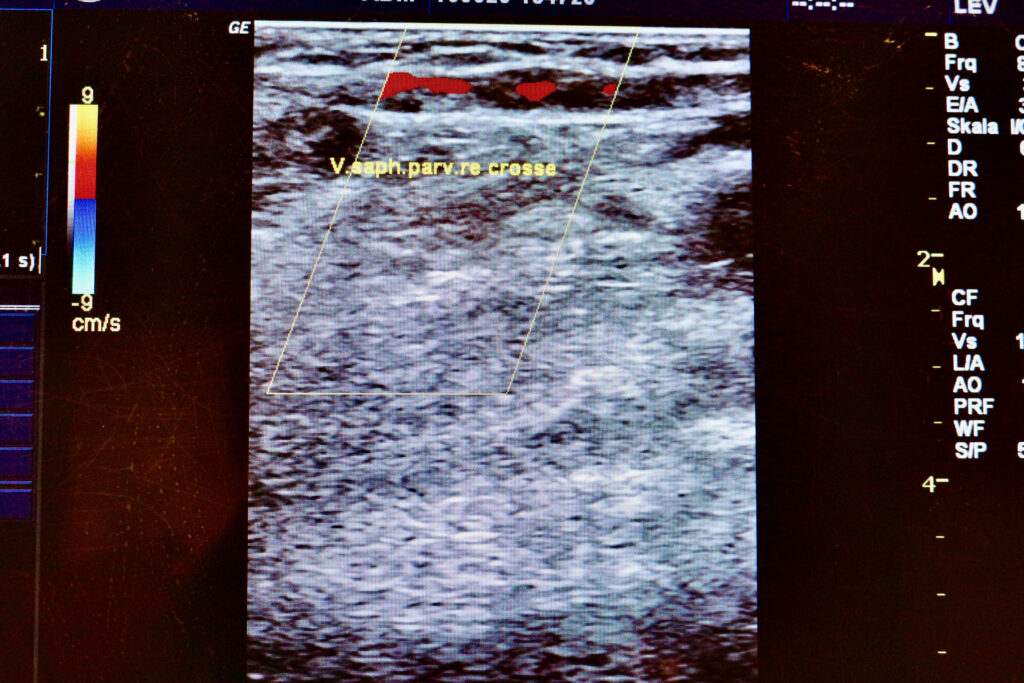
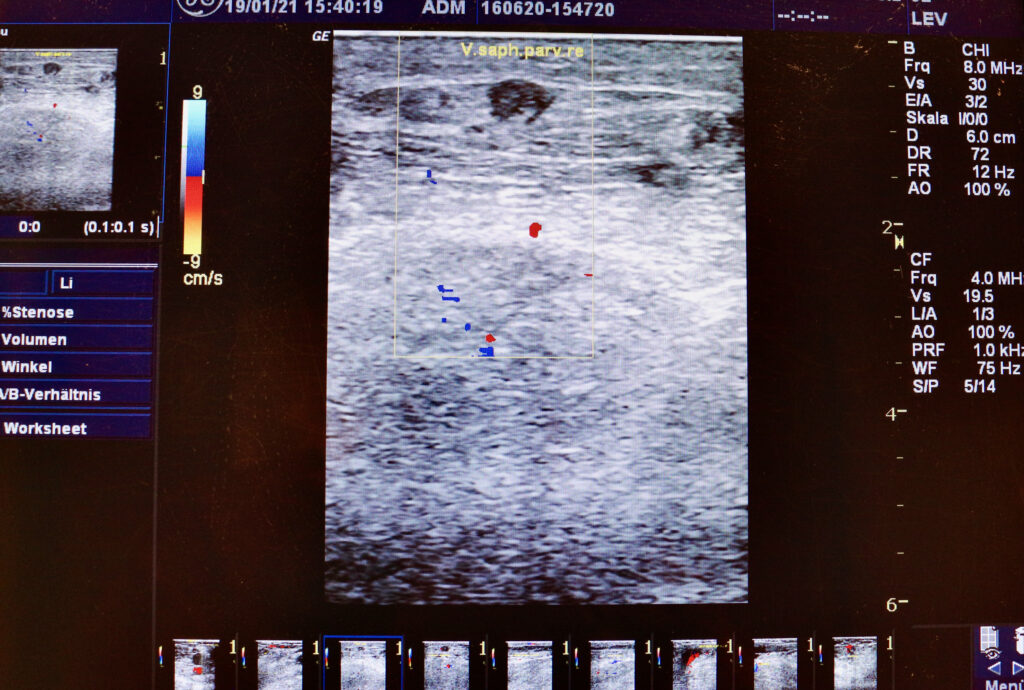
The 54-year-old patient presented to us for the first time in June 2020. The anamnesis, clinical, and ultrasound diagnosis revealed multiple varicose veins. Both the great saphenous veins and the right small saphenous vein were affected. We recommend the combination therapy using VenaSeal® on all 3 truncal veins simultaneously and then microfoam therapy of the lateral branch varicosis on both legs. The patient received an estimate for his insurance.
On January 11th. 2021, minimally invasive therapy using VenaSeal® catheters took place. Simultaneous therapy was planned for all three affected trunk varicose veins. First, we ablated the two great saphenous veins in the normal supine position, then the patient turned around on his own. During the duplex sonographic examination of the SSV, we immediately noticed the previously described thrombosis of the truncal vein. The questioning of the patient – he was awake and had renounced sedation – revealed a slight feeling of pressure in the right lower leg for 3 days.
We decided to aspirate the fresh thrombus in the vein using the VenaSeal® sheath. The vein was probed with a guidewire and sheath up to its confluence with the deep knee vein. We sucked most of the blood clot out of the truncal varicose vein, after cleaning the sheath we then inserted the VenaSeal® Teflon catheter into the vein using the known technique and glued the varicose vein with the known technique. There were no problems with that. At the same time, the patient was given the adjuvant therapeutic dose of a heparin preparation over 7 days (Arixtra® 7.5 mg 1 x daily).
The clinical and duplex sonographic follow-up examinations were on the 1st. and 7th. the post-therapeutic day each produced inconspicuous subjective clinical and duplex sonographic findings. All veins were effectively closed, and the patient is very satisfied and has no complaints. He started his professional activity on the first day after the intervention.
A further 7 days later, in accordance with our planned therapeutic procedure, we began with the microfoam therapy (sealing foam) for the lateral branch varicosis on both legs. As a rule, as in this special case, we start with the microfoam therapy of side branches and connecting veins about 14 days after the VenaSeal® – therapy of the three truncal varicose veins.
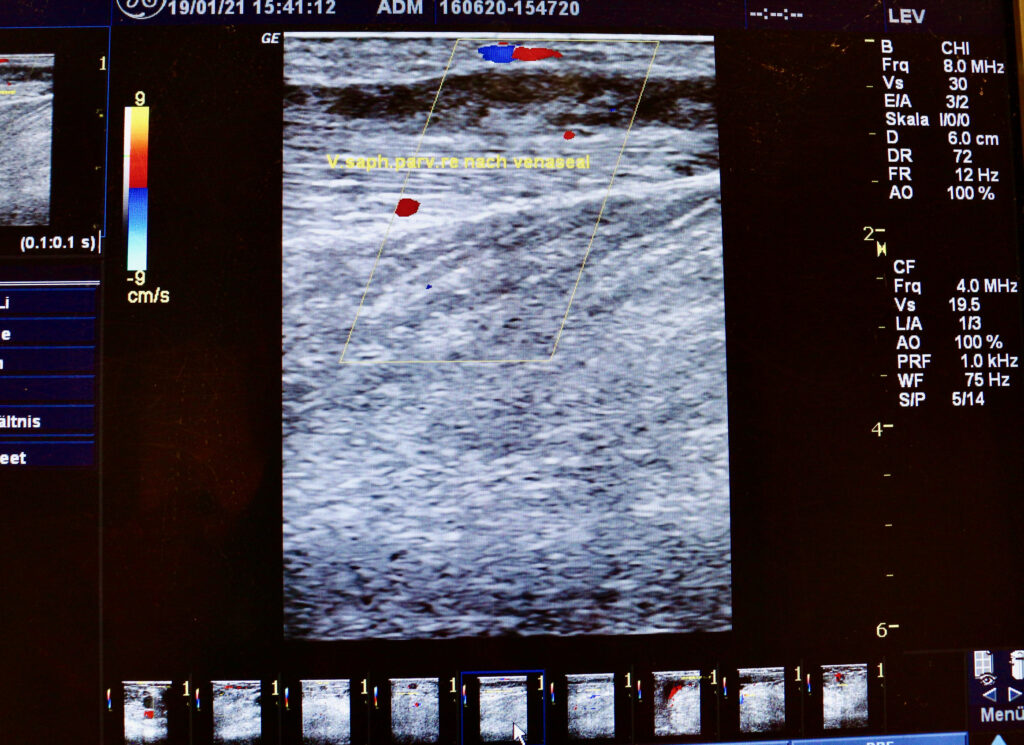
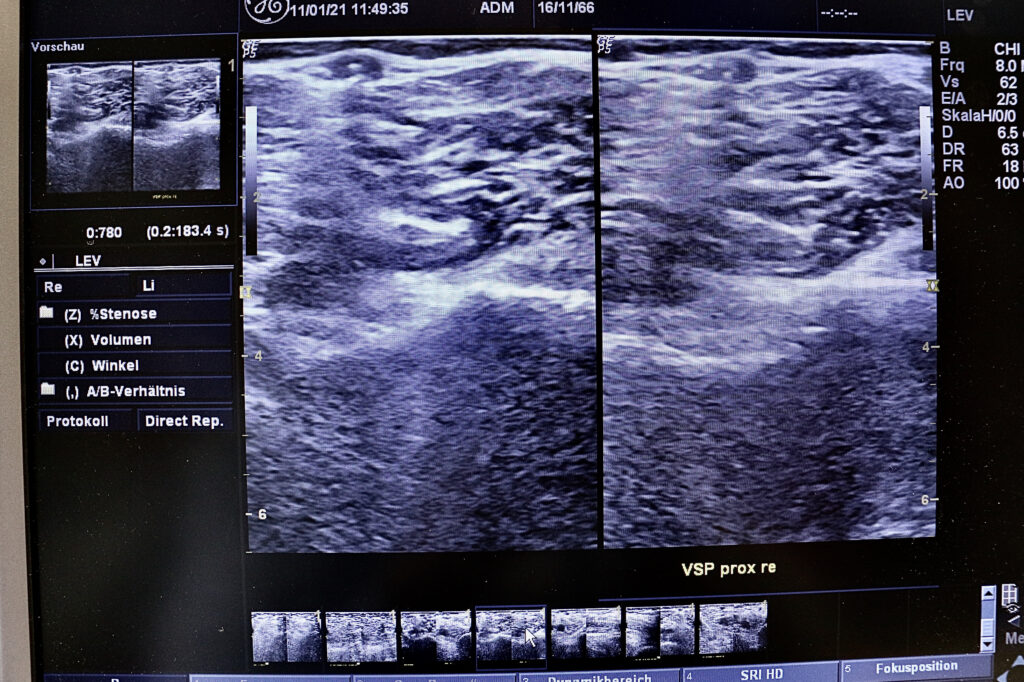
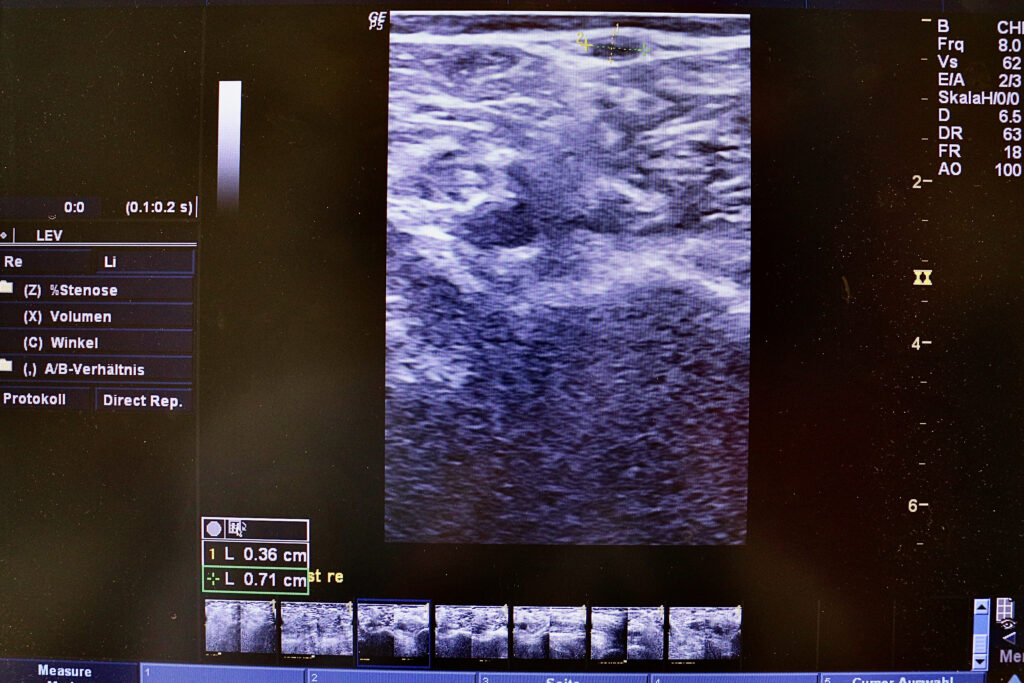
Saphenion® vein glue for the therapy of varicose vein thrombosis? Intraoperative sonography after VenaSeal®-therapy
Saphenion®: Venenkleber zur Therapie der Krampfaderthrombose? Die Diskussion
Saphenion®: vein glue for the therapy of varicose vein thrombosis: The discussion
Saphenion®: Venenkleber zur Therapie der Krampfaderthrombose? In der Therapie der Stammvaricosis haben sich kathetergestützte Verfahren, (Laser, Radiowelle, VenaSeal®) in den letzten 21 Jahren weitgehend durchgesetzt und die radikale Chirurgie in den Hintergrund treten lassen. Dies gilt weltweit, einschränkend muss aber gesagt werden, daß in Deutschland diese Verfahren nach wie vor nicht regelhaft durch gesetzliche Krankenkassen (Ausnahme sind Sonderverträge einzelner Kassen) erstattet werden. Das VenaSeal®-Verfahren ist aktuell immer noch das neueste Verfahren, obwohl es bereits 2011 in Europa und 2015 in den USA zugelassen worden ist.
Über den Einsatz der Katheterverfahren bei thrombosierten Stammkrampfadern finden sich nur sehr wenige Veröffentlichungen. Wir mussten in unserer Literaturrecherche bis in das Jahr 2012 zurück gehen. Damals veröffentlichte der Schweizer Kollege Prof. Markus Enzler seine Erfahrungen mit dem Einsatz des Laserkatheters bei Krampfaderthrombosen. Unser Erfahrungsbericht zum Einsatz des VenaSeal® – Systems in beschriebenen Fällen ist nach Rückfragen im Kollegenkreis und im VenaSeal® – Netzwerk der erste Bericht zur beschriebenen Problematik.
Grundsätzlich ist zu sagen, daß die Therapie von thrombosierten Stammkrampfadern an erster Stelle die Abheilung und Rekanalisation der thrombosierten Areale mittels medikamentöser Therapie vorsieht. Ein – zusätzliches – aktives Eingreifen ist nur bei Vorhandensein entsprechender Technik und entsprechender Erfahrung mit den Kathetersystemen zu empfehlen. Das Ziel dieses Vorgehens ist die Verkürzung und Abmilderung der thrombotischen Veränderungen in der Krampfadervene sowie der unbedingte Schutz vor einer tiefen Venenthrombose mit möglicher Lungenembolie.
Das VenaSeal® – System ist zunächst nicht für die Therapie einer thrombosierten Stammkrampfader zugelassen (deshalb ist eine separate Aufklärung des Patienten notwendig!). Gleichwohl ist es mit den vorhandenen Kathetern und Schleusen gut möglich und sinnvoll, bei frischen Thrombosen in der Stammkrampfader mit dem Schleusensystem zunächst die weichen Thromben im Sinne der Komplikationsvermeidung abzusaugen. Daran anschließend kann die defekte „Krampfader“ – Vene sofort effektiv verschlossen werden. Die Langzeit – Verschlussrate des VenaSeal® – Systems liegt bei > 96% über einen Beobachtungszeitraum von mehr als 8 Jahren.
Nebenwirkungen oder Komplikationen haben wir bei unserem therapierten Patienten bisher nicht gesehen. Die Rekonvaleszenz gestaltete sich verfahrensadäquat, auch die Nachbehandlung kann entsprechend unserer bei Saphenion® üblichen Standards erfolgen. Es gilt aber festzuhalten, dass der Venaseal® – Katheter nicht primär für eine Therapie der Krampfaderthrombose konzipiert wurde und deshalb Jeder dieser Eingriffe zunächst dem Einzelfall vorbehalten bleibt.
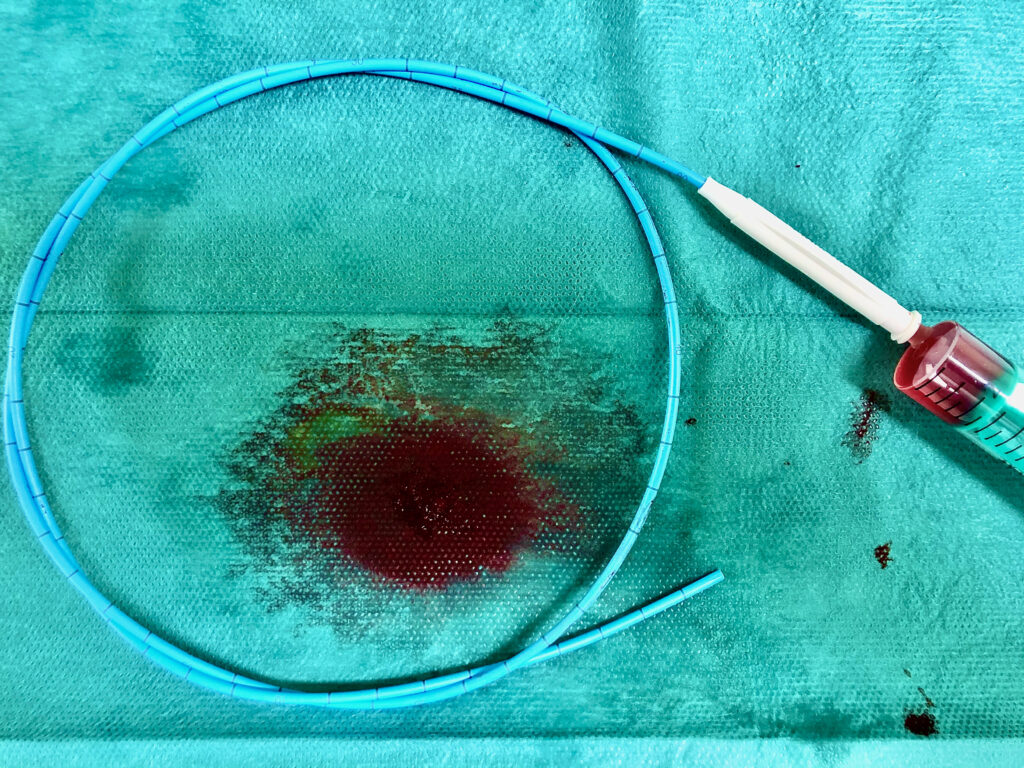
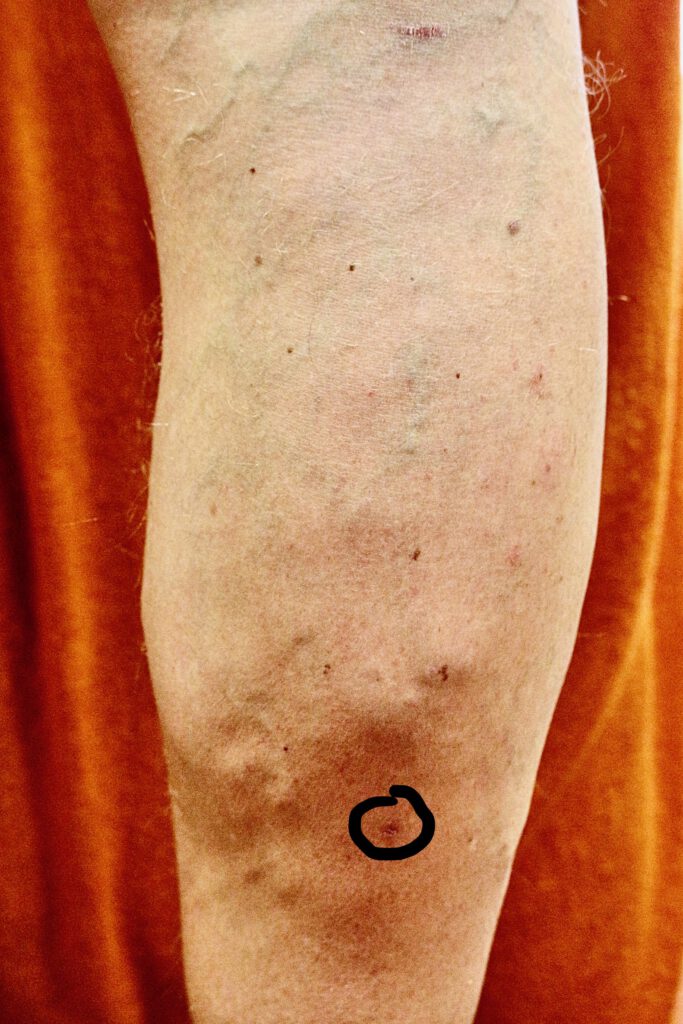
In the treatment of truncal varicose veins, catheter-supported procedures (laser, radio wave, VenaSeal®) have largely become established over the past 21 years and radical surgery has taken a back seat. This applies worldwide, but it must be said that in Germany these procedures are still not regularly reimbursed by statutory health insurance (except for special contracts with individual insurance). The VenaSeal® procedure is currently still the latest, although it was approved in Europe in 2011 and the USA in 2015.
There are very few publications on the use of catheter procedures for thrombosed varicose veins. We had to go back to 2012 in our literature research. At that time, the Swiss colleague Prof. Markus Enzler published his experiences with the use of the laser catheter for varicose vein thrombosis. Our experience report on the use of the VenaSeal® system in the cases described is the first report on the problem, so our colleagues and the German Network VenaSeal® reported.
It can be said that the therapy of thrombosed varicose veins is primarily the healing and recanalization of the thrombosed areas using medicament therapy. An – additional – active intervention is only recommended if the appropriate technology and experience with the catheter systems are available. This procedure aims to shorten and alleviate the thrombotic changes in the varicose vein as well as absolute protection against deep vein thrombosis with possible pulmonary embolism.
The VenaSeal® system is initially not approved for the treatment of thrombosed varicose (Therefore a separate explanation of the patient is necessary!). Nonetheless, with the existing catheters and locks, it is quite possible and useful to first suction off the soft thrombi in the case of fresh thromboses in the truncal varicose vein with the lock system to avoid complications. The defective „varicose vein“ can then be effectively closed immediately. The long-term closure rate of the VenaSeal® system is > 96% over an observation period of more than 12 years.
So far, we have not seen any side effects or complications in our treated patient. The convalescence was adequate for the process, and the follow-up treatment can also be carried out following our normal Saphenion® standards. It should be noted, however, that the Venaseal® catheter was not primarily designed for therapy of varicose vein thrombosis and therefore each of these interventions is initially reserved for individual cases.
Photos: Utzius
Papers / Links
A. Enzler: Endovenöse Thermoablation bei Thrombophlebitis; vasomed 6/2012; S. 337-338
.A. Enzler, D. Russell, J. Schimmelpfennig,
Thermal Ablation in the Management of Superficial Thrombophlebitis,
European Journal of Vascular and Endovascular Surgery, Volume 43, Issue 6, 2012, Pages 726-728, ISSN 1078-5884, https://doi.org/10.1016/j.ejvs.2012.02.012.
(http://www.sciencedirect.com/science/article/pii/S1078588412001013)
H. Decousus, I. Quéré, E. Presles, F. Becker, M.T. Barrellier, M. Chanut, et al: Superficial venous thrombosis and venous thromboembolism: a large, prospective epidemiologic study Ann Intern Med, 152 (2010), pp. 218-224; CrossRefView Record in ScopusGoogle Scholar2
M. Di Nisio, S. Middeldorp, I.M. WichersTreatment for superficial thrombophlebitis of the leg; Cochrane Database Syst Rev, 1 (2007), p. CD00498; View Record in ScopusGoogle Scholar3
G. Belcaro, A.N. Nicolaides, B.M. Errichi, M.R. Cesarone, M.T. De Sanctis, L. Incandela, et al: Superficial thrombophlebitis of the legs: a randomized, controlled, follow-up study; Angiology, 50 (7) (1999), pp. 523-529CrossRefView Record in ScopusGoogle Scholar4
M.A. Enzler, R.R. van den Bos: A new gold standard for varicose vein treatment? Eur J Vasc Endovasc Surg, 39 (1) (2010), pp. 97-98 ArticleDownload PDFView Record in ScopusGoogle Scholar5
C. Kearon, S.R. Kahn, G. Agnelli, S. Goldhaber, G.E. Raskob, A.J. Comerota: Antithrombotic therapy for venous thromboembolic disease; Chest, 133 (Suppl. 6) (2008), pp. 454-5458 View Record in ScopusGoogle Scholar6
J. Lawson: Presentation of the RCT recovery study VNUS ClosureFast vs. EVLA Radial 1470 nm25th Annual Meeting, European Society for Vascular Surgery. Athens(25 Sept. 2011) Google Scholar
Pillutla A, Hendrix MP, Ha J. Endovenous Glue-Induced Thrombosis in Nonthermal Glue Closure Therapy for Greater Saphenous Vein Insufficiency: A Single-Center Experience. J Vasc Interv Radiol. 2019 Jul;30(7):1075-1080. doi: 10.1016/j.jvir.2018.12.730. Epub 2019 Apr 1. PMID: 30948325.
Cho S, Gibson K, Lee SH, Kim SY, Joh JH. Incidence, classification, and risk factors of endovenous glue-induced thrombosis after cyanoacrylate closure of the incompetent saphenous vein. J Vasc Surg Venous Lymphat Disord. 2020 Nov;8(6):991-998. doi: 10.1016/j.jvsv.2020.01.009. Epub 2020 Mar 14. PMID: 32179036.
Langridge BJ, Onida S, Weir J, Moore H, Lane TR, Davies AH. Cyanoacrylate glue embolisation for varicose veins – A novel complication. Phlebology. 2020 Aug;35(7):520-523. doi: 10.1177/0268355520901662. Epub 2020 Jan 28. PMID: 31992129; PMCID: PMC7488820.
Chan YC, Law Y, Cheung GC, Ting AC, Cheng SW. Cyanoacrylate glue used to treat great saphenous reflux: Measures of outcome. Phlebology. 2017 Mar;32(2):99-106. doi: 10.1177/0268355516638200. Epub 2016 Jul 9. PMID: 27052039.
Chait J, Kibrik P, Alsheekh A, Ostrozhynskyy Y, Marks N, Rajaee S, Hingorani A, Ascher E. Radiofrequency Ablation Increases the Incidence of Endothermal Heat-Induced Thrombosis. Ann Vasc Surg. 2020 Jan;62:263-267. doi: 10.1016/j.avsg.2019.05.059. Epub 2019 Aug 5. PMID: 31394220.
Shaĭdakov EV, Mel’tsova AZ, Porembskaia OI, Kudinova EA, Korzhevskiĭ DÉ, Kirik OV, Sukhorukova EG. Opyt primeneniia tsianoakrilatnogo kleia pri éndovaskuliarnom lechenii varikoznoĭ bolezni [Experience with using cyanoacrylate glue in endovascular treatment of varicose veins]. Angiol Sosud Khir. 2017;23(4):62-67. Russian. PMID: 29240057.
Kibrik P, Chait J, Arustamyan M, Alsheekh A, Rajaee S, Marks N, Hingorani A, Ascher E. Resolution times of endovenous heat-induced thrombosis. J Vasc Surg Venous Lymphat Disord. 2020 Nov;8(6):1021-1024. doi: 10.1016/j.jvsv.2020.02.020. Epub 2020 Apr 19. PMID: 32321690.
Gohel MS, Heatley F, Liu X, Bradbury A, Bulbulia R, Cullum N, Epstein DM, Nyamekye I, Poskitt KR, Renton S, Warwick J, Davies AH; EVRA Trial Investigators. A Randomized Trial of Early Endovenous Ablation in Venous Ulceration. N Engl J Med. 2018 May 31;378(22):2105-2114. doi: 10.1056/NEJMoa1801214. Epub 2018 Apr 24. PMID: 29688123.
Raetz J, Wilson M, Collins K. Varicose Veins: Diagnosis and Treatment. Am Fam Physician. 2019 Jun 1;99(11):682-688. PMID: 31150188.
Healy DA, Kimura S, Power D, Elhaj A, Abdeldaim Y, Cross KS, McGreal GT, Burke PE, Moloney T, Manning BJ, Kavanagh EG. A Systematic Review and Meta-analysis of Thrombotic Events Following Endovenous Thermal Ablation of the Great Saphenous Vein. Eur J Vasc Endovasc Surg. 2018 Sep;56(3):410-424. doi: 10.1016/j.ejvs.2018.05.008. Epub 2018 Jun 9. PMID: 29895399.
Alghofili HH, Aljasser AA, Alyahya IA, Almohsen HA, Alwabel SA, Alhumaid AA, Iqbal K, Altuwaijri TA, Altoijry A. Endothermal heat-induced thrombosis after endovenous laser ablation: A single-centre experience. Semin Vasc Surg. 2020 Mar;32(3-4):89-93. doi: 10.1053/j.semvascsurg.2019.06.001. Epub 2019 Jun 12. PMID: 32553124.
Uthoff H, Keo HH, Spinedi L, Staub D. Perforator vein endovenous heat-induced thrombosis after laser ablation of the great saphenous vein. Vasa. 2020 Jun;49(4):330-332. doi: 10.1024/0301-1526/a000837. Epub 2019 Dec 6. PMID: 31808378.
Skeik N, Murray B, Carlson C, Jayarajan SN, Manunga J, Mirza A, Schmidt C. Determining Risk Factors for Endovenous Heat-induced Thrombosis after Radiofrequency Ablation. Ann Vasc Surg. 2020 Sep 18:S0890-5096(20)30840-2. doi: 10.1016/j.avsg.2020.08.148. Epub ahead of print. PMID: 32950624.
Jacobs CE, Pinzon MM, Orozco J, Hunt PJ, Rivera A, McCarthy WJ. Deep venous thrombosis after saphenous endovenous radiofrequency ablation: is it predictable? Ann Vasc Surg. 2014 Apr;28(3):679-85. doi: 10.1016/j.avsg.2013.08.012. Epub 2013 Nov 7. PMID: 24211409.
Zierau, UT: Die Bedeutung des >Krankheitsbildes der tiefen Bein – und Beckenvenenthrombose – Prinzipien der Diagnostik, Therapie um Prophylaxe am Charitè – Klinikum, Dissertation A, Medizinische Fakultät des Wissenschaftlichen Rates der Humboldt – Universität zu Berlin
